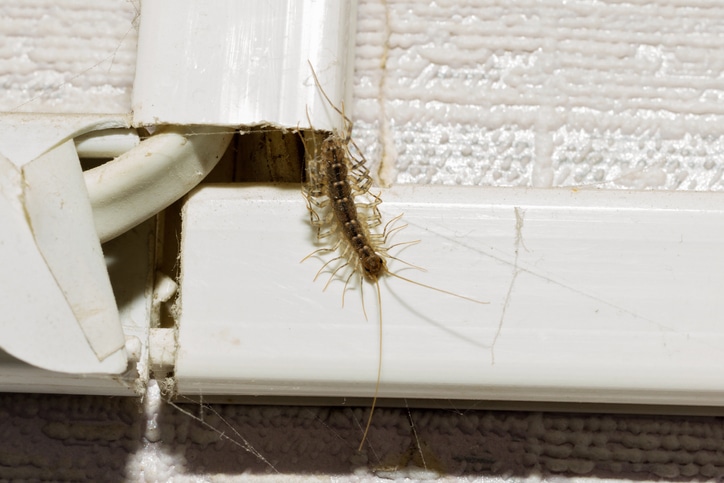Table Of Content

While some centipede species have compound eyes containing up to 200 optical units, others have a few simple eyes on each side of the head. While centipedes can be creepy to look at, there are plenty of effective DIY methods you can use to show them the door. Read on to learn more about a few different options you have when getting rid of centipedes.

Join the Orkin Pros

Millie Hurst is a freelance lifestyle writer with over six years of experience in digital journalism. She has written and edited countless features on home organization, decluttering and interior design and always hopes to inspire readers with new ways to enjoy their homes. She lives in Sheffield, South Yorkshire, and loves to weave nature-inspired decor and nods to time spent in Italy into her own home.
Sign up to the Homes & Gardens newsletter
A brown, yellowish color, they have dark stripes down their bodies and pale legs. They’re creatures meant to blend into undergrowth and shadows. This article covers all you need to know about this common house bug and its known habits. If you have any questions regarding pest control, leave them below. I’ve worked in many other industries as well, including consulting, managing, as well as at the ground level in fields including Food Service, Corporate Automotive sales, and finance. Whether it be providing counsel, content, or hands-on support; my goal remains to add value to the lives of the people I serve.
Natural Ways to Eliminate House Centipedes
Before you squish that creepy centipede, find out why it actually might be a useful house guest. Their presence may indicate that you have a moisture or insect problem, but they do not cause any damage themselves. They can’t regulate their temperature or stay hydrated, so it’s essential that wherever they live has lots of humidity and a warmer temperature.
Solved! Should You Really Kill House Centipedes?
It’s best to remove unused items such as old armchairs, old clothes, unused wardrobes, cardboard boxes, and other types of clutter from the basement as these provide nesting sites for centipedes. Clutter is one of the demonstrated elements centipedes by love. They hide behind clutter when you switch on the lights in the basement. Bark centipedes (Scolopocryptops sexspinosus) prefer to live outdoors.
Essential Tips to Avoid Bed Bugs When Traveling
Unlike other insects that leave droppings or destruction in their wake, you’re more likely actually to see a centipede. This doesn’t bode well for folks who can’t stand bugs, of course. Centipedes are long and move quickly, thanks to all those legs propelling them forward.
This critter is a common household pest, seeking out a moist environment and solid food source in the comforts of your home. While not overly dangerous to people, a centipede might not be a welcomed guest. The house centipede is an arthropod, a genus that includes insects as well as centipedes, millipedes, arachnids (spiders) and crustaceans (such as lobsters). The house centipede originated in the Mediterranean but now can be found across Europe, Asia, and North America. You can find diatomaceous earth at most garden supply centers and home improvement stores.
House centipedes don’t harm or destroy stored products, fabrics, pets, humans, or the structural integrity of your building and are generally only considered a nuisance. All house centipedes are venomous, but they typically run away from humans, and they very rarely bite. Even if house centipedes bite you, it’s considered harmless. While everyone wants to believe that they can solve every bug problem themselves, the truth is that some centipede infestations require professional assistance. Professional pest elimination companies also have access to higher-grade equipment and chemicals. These commercial-grade pesticides and insecticides require specialized application but provide you with more comprehensive results.
Tackle any moisture concerns
The Florida blue centipede in the Southeastern U.S. is the exception, as its bite can cause a reaction like a bee sting. Many homeowners dislike having any insects or arthropods in the home and are very interested to know how to get rid of centipedes. Indoors, this may mean basements and closets or floor drains. Outdoors, you’ll often find them in logs and piles of leaf litter or under stones or wood. However, if you think you have found evidence of house centipede infestation, you can control house centipedes in your home by applying the appropriate treatment and limiting favorable conditions.
It needs to be sprayed directly on centipedes for a few seconds. The main problem with this solution is the actual speed of centipedes as they can always make a quick escape. Exterminators might be needed in case of serious infections. Proper insecticide might be applied by professionals following a thorough examination of all of the home areas where centipedes live. Some people only recommend removing centipedes instead of killing them.
As a result, centipedes are unlikely to invade in large numbers. If you have a house centipede problem, there are several pest control products that can help. You'll want to use insecticides inside your home to quickly get rid of the infestation then apply a perimeter barrier to keep them out. If you don’t like the idea of spreading boric acid or insecticides around your home, traps can be extremely effective for house centipedes if placed properly. There are a number of great traps out there, but the two brands we recommend are listed below.
Exterminators usually keep the spraying to the exterior of the home at the entry points. However, if the infestation indoors is severe enough, they might also spray indoors. Their round heads point downward and they don’t have forcipules because they don’t have to attack the damp, decaying wood and leaves they prefer to eat.
Getting the Bugs Out: 22 Cheap, Natural Ways to Rid Your Home of Pests - Cheapism
Getting the Bugs Out: 22 Cheap, Natural Ways to Rid Your Home of Pests.
Posted: Thu, 11 Apr 2024 07:00:00 GMT [source]
If your pet has been stung by a centipede, consult a veterinarian to treat the sting; however, your pet should be fine. Both arthropods have segmented bodies, but centipedes have just one pair of legs per segment while millipedes have two. You can see the eyes and mouthparts of centipedes, as well as their forcipules, the pincers that inject poison into their insect prey so they can feast. Centipedes are not insects, though they are part of the same arthropod family, along with arachnids and crustaceans.
Now that you know about the house centipede and its ways, you can rest easy knowing it won’t cause any harm to your home or family. House centipedes stay in environments where they can thrive. If there are many of them, there could be an underlying pest problem you need to have professionally addressed. Or, they might just really enjoy your house and want to stay. Since their diets consist of only insects, arachnids, and other arthropods, it’s safe to say they aren’t going to go after you or have any desire to hurt a person. If you think a spider is quick at being a recluse (including the actual brown recluse spider), these centipedes run at nearly 1 ½ feet per second!
They are both hunters and prey, so their lifespan can be cut short if they get caught in the wrong place at the wrong time. These many legs give them a hairy appearance, and it can be unsettling to see them moving about at great speed. It’s startling to see one on any surface, but just know they’re far more startled to see you. 'Peppermint and tea tree do disrupt pest scent trails, pheromones, and sensory organs, and yes, they can even help kill a pest on contact.

No comments:
Post a Comment